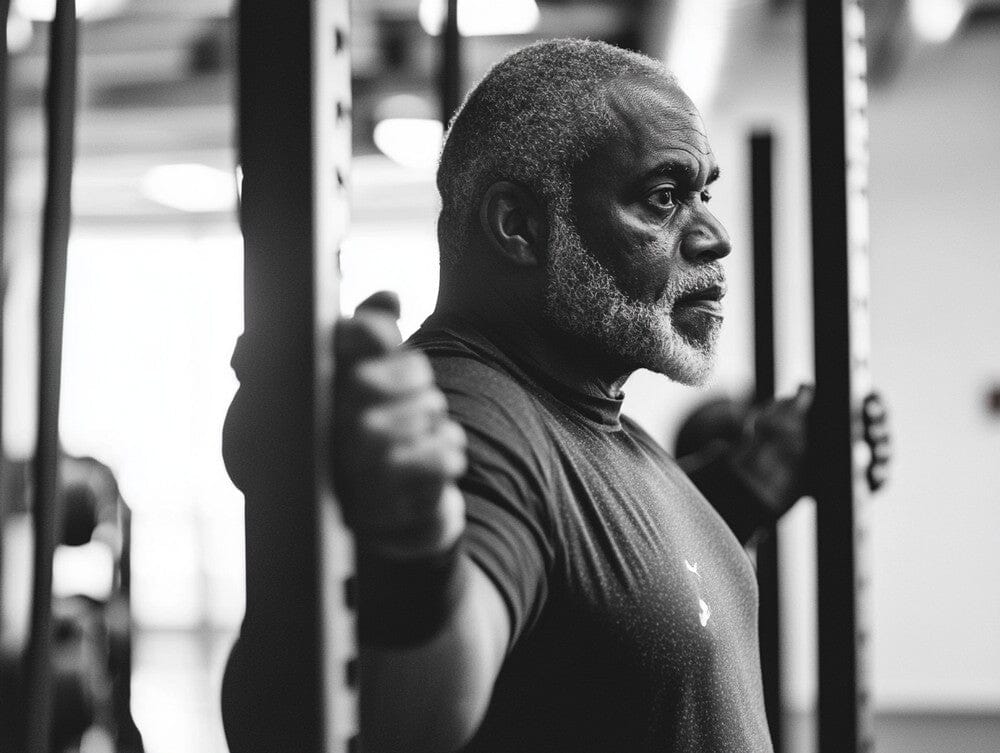As we age, our bodies go through natural changes, including a gradual loss of muscle mass, flexibility, and overall physical strength.
For people over 50, strength training isn’t just an option—it’s a game-changer. It can help you retain muscle, improve balance, boost bone density, and elevate your mood.
This guide will walk you through the essentials of strength training over 50, giving you the knowledge and confidence to safely incorporate it into your life.
Why Strength Training is Essential After 50
Strength training is essential for older adults because it directly combats some of the most common challenges of aging. While cardio exercises are often seen as the go-to for fitness, strength training builds the foundation for physical resilience, helping you stay independent and active.
The Physical Benefits of Strength Training
One of the most valuable benefits of strength training over 50 is its impact on muscle preservation and bone density. As we get older, our muscles naturally weaken, and bones become more brittle. Regular strength training can slow down, or even reverse, these effects, keeping your body robust and reducing the risk of fractures and falls.
Engaging in exercises that target major muscle groups can lead to better posture, improved balance, and increased endurance, making it easier to handle daily tasks with ease.
Mental Health Benefits of Lifting Weights
Strength training isn’t just about physical health; it’s a powerful tool for mental well-being, too. Lifting weights stimulates the release of endorphins, the body’s natural mood lifters, which can reduce stress and anxiety. Additionally, setting and reaching fitness goals gives a sense of accomplishment that builds self-esteem and resilience.
For older adults, who might be dealing with life transitions or stress, the mental benefits of a regular strength training workout can make a meaningful difference in overall happiness.
Preventing Muscle Loss with Regular Workouts
Muscle mass naturally declines with age—a process known as sarcopenia. Starting in our 30s and accelerating after 50, this muscle loss can lead to reduced mobility and a decreased quality of life. Strength training helps slow this decline and can even build muscle, helping you stay agile and energetic.
Regular workouts that engage both large and small muscle groups help maintain strength, allowing you to continue doing the things you love without limitation.
How Strength Training Helps Combat Age-Related Muscle Loss

Age-related muscle loss isn’t inevitable. Strength training effectively prevents or reverses this loss, keeping your muscles strong and reducing the physical effects of aging. By focusing on safe and gradual progression, people over 50 can rebuild and retain muscle that enhances their mobility and vitality.
Understanding Age-Related Muscle Loss
Age-related muscle loss, known scientifically as sarcopenia, can begin as early as age 30 and speeds up with each passing decade. Strength training works against this by stimulating the growth of muscle fibers, slowing down this process and preserving strength and endurance.
Building Muscle Over 50 with Proper Techniques
Strength training over 50 doesn’t require lifting the heaviest weights; it’s about using proper form and technique. This might mean focusing on body weight exercises or resistance bands before moving to free weights or machines. Quality, rather than quantity, is the key to safe and effective workouts.
The Role of Resistance Training in Muscle Health
Resistance training—whether through weights, bands, or body weight—promotes muscle health by encouraging muscle growth and retention. This form of training is ideal for those over 50, as it helps maintain strength, balance, and coordination.
Incorporating resistance exercises into your routine supports functional fitness, keeping you ready for everyday activities.
The Basics of Starting a Strength Training Program Over 50
Starting a strength training program can feel overwhelming, especially if it’s been a while since you last exercised. Begin with exercises that feel manageable, and remember that the goal is to build a sustainable routine.
Consulting a Personal Trainer or Physical Therapist
If you’re new to strength training, consulting with a certified personal trainer or physical therapist can be beneficial. They can guide you in choosing the right exercises, teaching proper form, and building a program tailored to your fitness level and goals.
Look for trainers with experience working with older adults to ensure a safe, supportive experience.
Essential Tips for Learning Proper Form
Proper form is crucial in strength training, particularly for those over 50. Incorrect form can lead to strain and injury. Start with lighter weights and take time to master each movement before increasing intensity.
Resources like instructional videos, classes, or supervised training sessions are invaluable for building a solid foundation.
The Importance of Consistency and Patience
Consistency is the secret to long-term success. Begin with a manageable schedule, perhaps two or three days a week, and gradually increase as you feel stronger. Remember that progress takes time, and patience is essential. Strength builds gradually, but the benefits are long-lasting.
Strength Training Exercises Suitable for Older Adults
There are many types of strength exercises suited for older adults, from bodyweight exercises to free weights and machines. Each has unique benefits, and a varied routine can target all major muscle groups for balanced strength.
Bodyweight Exercises to Get Started
Bodyweight exercises are perfect for beginners. Moves like squats, lunges, and push-ups are simple yet effective ways to build strength without any equipment. They also improve balance and coordination.
These exercises can be done anywhere and modified as you progress.
Using Light Weights to Build Muscle
Starting with light weights helps develop strength without overstressing the muscles and joints. Using dumbbells or resistance bands, you can begin with exercises that build arm, shoulder, and chest muscles. As your confidence grows, gradually increase the weight.
Incorporating Machine Exercises Safely
Machines offer added stability, making them a safe option for beginners. They also provide support, which can be particularly helpful if balance is a concern. Popular machines include the leg press, chest press, and seated row, each targeting specific muscle groups effectively.
Key Muscle Groups to Focus on in Strength Training
For a balanced strength training program, it’s essential to work all major muscle groups. This approach not only builds overall strength but also improves posture and reduces injury risk.
Targeting the Upper Body with Strength Exercises
Upper body exercises, like shoulder presses and rows, strengthen muscles in the arms, shoulders, and chest. These exercises make it easier to perform everyday tasks, from lifting groceries to reaching overhead.
Core Exercises for Stability and Balance
The core is central to balance and stability. Plank variations, along with exercises on a stability ball, engage and strengthen the muscles around your abdomen, lower back, and hips.
A strong core supports your entire body and can reduce back pain.
Lower Body Strength for Mobility and Independence
Lower body strength is vital for activities like walking, climbing stairs, and even getting out of a chair. Exercises like leg presses, squats, and lunges strengthen the quadriceps, hamstrings, and calves.
How to Build Muscle Mass Safely After 50
Building muscle mass after 50 requires a focus on safety and consistency. Gradually increase intensity, and allow your body time to adapt to each stage of training.
Progressive Overload for Older Adults
Progressive overload means gradually increasing the weight or reps over time. It’s a safe and effective method for building muscle, even for beginners. Start small and work your way up to more challenging loads.
Focusing on Muscle Recovery and Rest
Recovery is just as important as the workout itself. Older muscles take longer to repair, so ensure you’re allowing at least one day of rest between strength sessions targeting the same muscle group.
How to Monitor Progress in Building Muscle
Tracking progress can keep you motivated and help you adjust your routine as needed. Measurements of strength and endurance, like lifting a heavier weight or completing more reps, indicate muscle growth.
Developing a Weekly Strength Training Routine

A structured weekly routine can keep you on track and prevent burnout. Aim for a balance of exercises that target different muscle groups, with rest days built in for recovery.
Structuring Your Weekly Exercise Routine
A balanced routine might include two upper body days, two lower body days, and one or two days focused on core exercises. Customize based on your schedule and fitness level.
Balancing Upper and Lower Body Workouts
It’s important to balance upper and lower body workouts to avoid overloading any single area. This approach builds a harmonious, functional strength across the body.
Incorporating Rest Days for Muscle Recovery
Rest days are crucial for allowing muscles to repair and grow. Plan at least one day of rest between strength workouts targeting the same muscle group.
How to Warm Up and Cool Down Properly
Warm-ups and cool-downs help prevent injuries, support recovery, and make each workout more effective. They’re simple but valuable steps that shouldn’t be overlooked.
Warming Up: Essential Tips for Safety
Start each session with a gentle warm-up, like walking or dynamic stretching. This prepares the muscles for exercise and reduces the risk of strains.
Cooling Down: Stretching Techniques for Recovery
Cool down after each session with gentle stretching. Focus on the muscles you worked, holding each stretch for 15-30 seconds to aid flexibility and reduce soreness.
Flexibility and Mobility Exercises
Incorporating flexibility and mobility exercises enhances joint health and range of motion, making everyday movements more comfortable and less taxing.
Avoiding Common Mistakes in Strength Training Over 50
Strength training can be incredibly safe and beneficial, but common mistakes can limit progress or lead to injury. Being aware of these mistakes will help you stay on track and get the most out of each workout.
Lifting Too Much Weight Too Soon
It’s tempting to push for fast results, but lifting too heavy too soon can lead to injuries. Start with weights you can handle comfortably and focus on mastering the technique before moving up.
Neglecting Form and Technique
Good form ensures that your workouts are effective and safe. If you’re unsure about your form, consider working with a trainer or checking instructional resources.
Not Taking Enough Rest
Skipping rest days may seem productive, but it can hinder progress. Allow your body time to recover, as rest is when muscles rebuild and strengthen.
Staying Motivated and Building a Strong and Healthy Body
Staying motivated is the key to maintaining a strength training routine, especially as it becomes part of your lifestyle. Tracking your progress, setting realistic goals, and celebrating small achievements all help keep the momentum going.
Setting Realistic Goals
Realistic goals prevent discouragement and keep you focused. Setting small, attainable milestones allows you to track progress without feeling overwhelmed.
Tracking Your Progress
Recording your workouts helps you see improvements over time. Seeing progress keeps motivation high and makes the effort feel worthwhile.
Celebrating Small Wins
Every step forward is a victory, so celebrate small wins. Whether it’s lifting a little more weight or completing an extra rep, each improvement is a testament to your dedication and strength.
Source link

